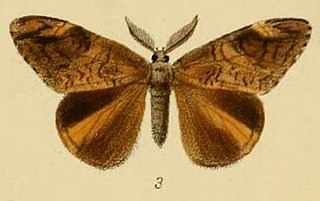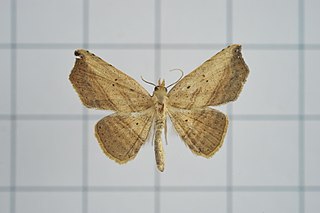Related Research Articles

Sufetula is a genus of moths of the family Crambidae.
Dunira is a genus of moths of the family Erebidae. The genus was erected by Frederic Moore in 1885.
Hypenagonia is a genus of moths of the family Erebidae first described by George Hampson in 1893. The adult moths have pale brown wings with a dark band across each wing. The wingspan of these moths is about 1 centimeter.

Aroa is a genus of moths in the subfamily Lymantriinae first described by Francis Walker in 1855. Species are distributed in South Africa, China, throughout India, Sri Lanka, Myanmar, and Java.

Laelia is a genus of tussock moths in the family Erebidae. The genus was described by Stephens in 1828. Species are well distributed throughout Europe, Japan, China, India, Sri Lanka, Myanmar and Java.

Cryptoblabes is a genus of small moths belonging to the snout moth family (Pyralidae). They are the type genus of the Cryptoblabini tribe of the huge snout moth subfamily Phycitinae. At least one representative of this genus nowadays occurs in many parts of the world, though this is the result of accidental introductions by humans; most species of Cryptoblabes are fairly restricted in range.
Cryptoblabes myosticta is a species of snout moth in the genus Cryptoblabes. It was described by George Hampson in 1903. It is found in India.

Coenodomus is a genus of snout moths. It was described by Walsingham in 1888, and is known from India, Papua New Guinea, Bhutan, the Philippines, the United States, Indonesia, China, and Sri Lanka.
Etiella grisea is a species of snout moth in the genus Etiella. It was described by George Hampson in 1903. It is found in Sri Lanka, the Chagos Archipelago, Tahiti, the Cook Islands, Samoa, Fiji, the New Hebrides, the Solomon Islands, Australia, the Tanimbar Islands, New Guinea and Guam.
Euzopherodes is a genus of snout moths. It was described by George Hampson in 1899.
Oedilepia is a monotypic snout moth genus described by George Hampson in 1930. Its single species, Oedilepia striginervella, was originally described under the genus Nephopterix by Hampson in 1903. It is found in Sri Lanka.
Chloroclystis rectaria is a moth in the family Geometridae. It was described by George Hampson in 1903. It is endemic to Sri Lanka.

Corgatha atrifalcis is a moth in the family Erebidae. It is found in Sri Lanka.
Cryptoblabes angustipennella, the earhead caterpillar, is a moth of the family Pyralidae. It was first described by Émile Louis Ragonot in 1888. It is found in India and Sri Lanka. The caterpillar is a pest of Eleusine coracana.
Picrogama nigrisparsalis is a moth of the family Pyralidae first described by George Hampson in 1903. It is found in Sri Lanka.
Enispa croceicincta is a moth of the family Noctuidae first described by George Hampson in 1903. It is found in Sri Lanka.
Enispa rubrifuscaria is a moth of the family Noctuidae first described by George Hampson in 1903. It is found in Sri Lanka.
Pseudozarba mianoides is a moth of the family Noctuidae first described by George Hampson in 1893. It is found in Sri Lanka.
References
- ↑ "Species Details: Cryptoblabes ephestialis Hampson, 1903". Catalogue of Life. Retrieved 29 May 2018.
- ↑ Koçak, Ahmet Ömer; Kemal, Muhabbet (20 February 2012). "Preliminary list of the Lepidoptera of Sri Lanka". Cesa News. Centre for Entomological Studies Ankara (79): 1–57 – via Academia.
- ↑ "HOSTS - a Database of the World's Lepidopteran Hostplants". The Natural History Museum. Retrieved 28 March 2018.